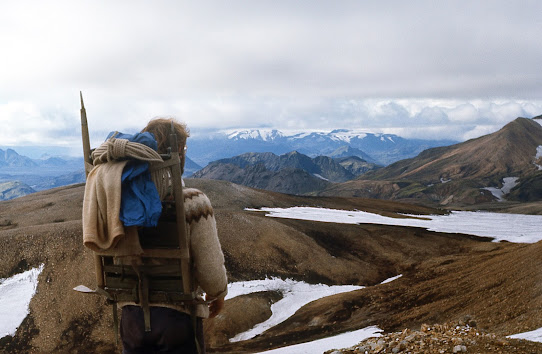links to: introduction and index - previous day - next day
Wednesday 31st August 1977
A week since we flew to Iceland.
 |
| The Strútslaug Hut |
Strútslaug-14, as someone has renamed it, was built by Dick Phillips for his own tours. It is cold, cramped, and the floor is volcanic gravel. Most of us sleep on the gravel but there is room for three ‘athletes’ on a seven-foot high sleeping platform. Getting on to it involves a stomach-wrenching reverse-somersault technique. Of course, only the Bridge School G.T. boys have strong enough stomach muscles to do it.
Yet, they are the ones most likely to have to go outside in the night. There must be some correlation between the strength of one’s stomach muscles and the need to pee. Perhaps strong stomach muscles exert greater pressure on the bladder. As we continue to drink big mugs of cocoa each night, those on the sleeping platform have to jump down in the dark. It is not a good idea to sleep directly beneath the edge.
In the mornings there is a well established order of getting up. I am told that Ed and Neville are always first. I really don’t know because I am always one of the last. I compete with three others for the Rip van Winkle award.
We are staying at Strútslaug for two nights to allow a day’s walking on the Torfajökull ice cap. It lies on an extensive volcanic cone known the ‘high rhyolite’. However, because of the red-raw state of my heels, it seems fairer to the others if I take the day off, so I stay at the hut. The complaints about the frequent stops to wait for me the previous day have got to me. Ed should really have done the same because his feet are as bad as mine, but he goes off with the others.
 |
| Geothermal pool at Strútslaug |
After they have gone, I go down to the geothermal pools for a long soak. The strong mineral content works wonders on my scabby blisters. Not only does it heal heels, it is also mentally therapeutic. To tell you the truth, I am not very good at spending all day and night, seven days a week, with people I don’t know. It is hard enough with people I do know. I would have been hopeless in the army. Back at the hut I read a book of D. H. Lawrence short stories. I enjoy the day on my own.
Obsidian, a heavy, black, glassy igneous rock, lies all around. I pick up a piece to take home. Gavin has collected about five pounds (2.25 kg) of the stuff. Rather him than me carrying the extra weight. I’m glad I’m not on his Christmas present list.
I still have mine:
 |
| Obsidian from Iceland |
The others return having had a superb day. Below is Neville’s picture of Paul, the leader, overlooking one of the views I missed. However, I am informed we will be walking part of the same route again tomorrow.
 |
Even for just a day’s walk, Paul still takes his carrying frame, albeit not as heavily laden as usual. He has a rope and two ice axes for emergencies. I think these must be stored at the Strútslaug hut because I haven’t noticed them before, even though he always carries far more weight than anyone else, including fuel for cooking. The sturdy frame appears to be constructed out of angle irons. I suspect it incorporates scaffolding poles and a couple of rolled steel joists as well.
This Icelandic saga is turning out to be even longer than anticipated. We are now half way along the route, east to west, north-east of the Mýrdalsjökull glacier, with four more days walking to go:
(next part)
Some names and personal details have been changed. I would be delighted to hear from anyone who was there.




